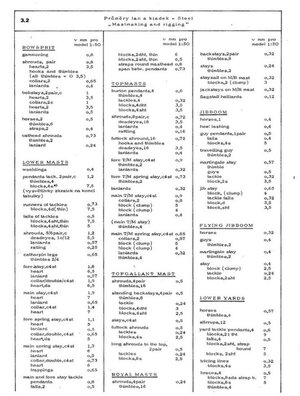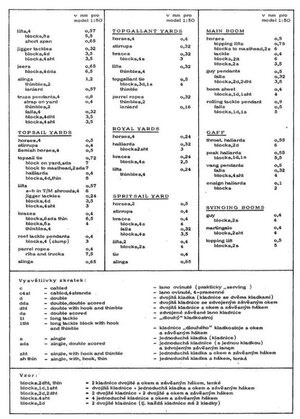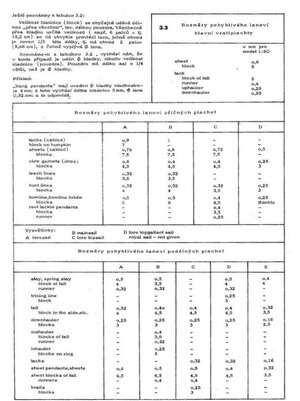Thanks a ton Jack, I appreciate you posting it !yes. sorry about the confusion. that is my fault. I thought I had the Dan Vadas spreadsheet, but I must have deleted it. But the one one I shared is just a simplified version, even though some of the writing is not english. Anyways, that is the one I use.
-

Win a Free Custom Engraved Brass Coin!!!
As a way to introduce our brass coins to the community, we will raffle off a free coin during the month of August. Follow link ABOVE for instructions for entering.
You are using an out of date browser. It may not display this or other websites correctly.
You should upgrade or use an alternative browser.
You should upgrade or use an alternative browser.
Thank you for posting this excel file.
Kudos to the individual who put this together as it is very well done.
Kudos to the individual who put this together as it is very well done.
1. This is for sailing warships of the 18th century, any country. Depending upon who the master rigger was, what the rope inventory of the yard where the ship was being built was, the availability of raw materials for the yard's ropewalk, the budget, the corruption of the local yard administration, the attention paid to the current establishment, from marling to mainstay, the number of lines for a 6th rate frigate might be 25 to 30 and for a 1st rate the number of lines might be 35 to 40.
2. The rigging of a sailing ship was(is) far more complex than the model makers allow for. There were probably 3 to 4 lines on a real vessel for every one line shown on a model plan: the same problem with belaying points. You really only get into the details of this problem if you fully rig your model with sails (all of them), etc
3. At scale, I build at 1/48, I end up with about 15 to 20 sizes for a frigate. Any vessel larger than that is just tooooo big. Your comment about there being very little measurement differential between some of the scale rope sizes is very valid. You just have to use a little judgement about which sizes to combine. I use a 0.001" dial caliper to make all rope measurements; amazon.com for about $25.00. I limit my line sizes to a differential of no less than 0.002" (hopefully). Most of the real lines are in the 1/2" (0.1" ) to 1" (0.02") range.. My scale sizes in this range would be about 0.010", 0.012", 0.014", 0.016", 0.018" and 0.020" (more or less). This range is the hardest range to account for: 0.008' line is about the smallest you can work with and is next to impossible to make. To make a 0.012" line (3SR/LH) you need raw material that is 0.006" in diameter: I buy commercial thread for the 0.010", 0.012" and 0.014" sizes.
4. Hope this helps.
2. The rigging of a sailing ship was(is) far more complex than the model makers allow for. There were probably 3 to 4 lines on a real vessel for every one line shown on a model plan: the same problem with belaying points. You really only get into the details of this problem if you fully rig your model with sails (all of them), etc
3. At scale, I build at 1/48, I end up with about 15 to 20 sizes for a frigate. Any vessel larger than that is just tooooo big. Your comment about there being very little measurement differential between some of the scale rope sizes is very valid. You just have to use a little judgement about which sizes to combine. I use a 0.001" dial caliper to make all rope measurements; amazon.com for about $25.00. I limit my line sizes to a differential of no less than 0.002" (hopefully). Most of the real lines are in the 1/2" (0.1" ) to 1" (0.02") range.. My scale sizes in this range would be about 0.010", 0.012", 0.014", 0.016", 0.018" and 0.020" (more or less). This range is the hardest range to account for: 0.008' line is about the smallest you can work with and is next to impossible to make. To make a 0.012" line (3SR/LH) you need raw material that is 0.006" in diameter: I buy commercial thread for the 0.010", 0.012" and 0.014" sizes.
4. Hope this helps.
- Joined
- Nov 8, 2020
- Messages
- 17
- Points
- 58

Some years ago I found a good source in Steel´ >Masting and rigging < and I recalculated the individual data for the needs of the schooner brig >Prince de Neufchatel < model in 1:50 scale.I put it here for illustration, maybe it will help.
Nr 3.2 - diameters of ropes and blocks,3.3 >the dimensions of the running rigging of the square sails,(pricnych plachet) last > dimension of the fore-and -aft sails running rigging.(podelnych plachet).




Nr 3.2 - diameters of ropes and blocks,3.3 >the dimensions of the running rigging of the square sails,(pricnych plachet) last > dimension of the fore-and -aft sails running rigging.(podelnych plachet).




Last edited:
- Joined
- Nov 8, 2020
- Messages
- 17
- Points
- 58

The books about rig and rigging which I can recommend
I can recommend the book by David Steel, from which I used individual links.
is available online for free > https://maritime.org/doc/steel/ <
The next very helpful is book >Young sea officer sheet anchor,where you can find plenty information about rig in the first quarter of the 19th century.
It is for free too, you can download from>Interhet archive >> https://archive.org/details/youngseaofficers00leve/mode/2up
If you have the chance, I recommend the book , which can still be found in an English version> by Petrejus, E.W. MODELLING THE BRIG-OF-WAR "IRENE"
about brig construction in the middle of the 19th century. As I can remember with tables for model rigging
> https://www.biblio.com/modelling-the-brig-of-war-by-petrejus-e-w/work/2771074 <
Very useful is next book by George Biddlecombe>the Art of rigging ... -
> https://www.bookdepository.com/Art-...be/9780486263434?ref=pd_detail_1_sims_b_p2p_1
I can recommend the book by David Steel, from which I used individual links.
is available online for free > https://maritime.org/doc/steel/ <
The next very helpful is book >Young sea officer sheet anchor,where you can find plenty information about rig in the first quarter of the 19th century.
It is for free too, you can download from>Interhet archive >> https://archive.org/details/youngseaofficers00leve/mode/2up
If you have the chance, I recommend the book , which can still be found in an English version> by Petrejus, E.W. MODELLING THE BRIG-OF-WAR "IRENE"
about brig construction in the middle of the 19th century. As I can remember with tables for model rigging
> https://www.biblio.com/modelling-the-brig-of-war-by-petrejus-e-w/work/2771074 <
Very useful is next book by George Biddlecombe>the Art of rigging ... -
> https://www.bookdepository.com/Art-...be/9780486263434?ref=pd_detail_1_sims_b_p2p_1
I would be interested in looking at this excel file. Thanks for sharingI don't have a direct answer to your question because it seems to depend on which company you buy a ship from, but there is a spreadsheet circulating by someone named Dan Vadas that calculates all that stuff with a few simple inputs. I can send it to you if you like. Let me know
- Joined
- Oct 9, 2020
- Messages
- 2,190
- Points
- 488

Go to the masts and rigging section, and you should see it.
Hallo @bill361. This is for sailing warships of the 18th century, any country. Depending upon who the master rigger was, what the rope inventory of the yard where the ship was being built was, the availability of raw materials for the yard's ropewalk, the budget, the corruption of the local yard administration, the attention paid to the current establishment, from marling to mainstay, the number of lines for a 6th rate frigate might be 25 to 30 and for a 1st rate the number of lines might be 35 to 40.
2. The rigging of a sailing ship was(is) far more complex than the model makers allow for. There were probably 3 to 4 lines on a real vessel for every one line shown on a model plan: the same problem with belaying points. You really only get into the details of this problem if you fully rig your model with sails (all of them), etc
3. At scale, I build at 1/48, I end up with about 15 to 20 sizes for a frigate. Any vessel larger than that is just tooooo big. Your comment about there being very little measurement differential between some of the scale rope sizes is very valid. You just have to use a little judgement about which sizes to combine. I use a 0.001" dial caliper to make all rope measurements; amazon.com for about $25.00. I limit my line sizes to a differential of no less than 0.002" (hopefully). Most of the real lines are in the 1/2" (0.1" ) to 1" (0.02") range.. My scale sizes in this range would be about 0.010", 0.012", 0.014", 0.016", 0.018" and 0.020" (more or less). This range is the hardest range to account for: 0.008' line is about the smallest you can work with and is next to impossible to make. To make a 0.012" line (3SR/LH) you need raw material that is 0.006" in diameter: I buy commercial thread for the 0.010", 0.012" and 0.014" sizes.
4. Hope this helps.
we wish you all the BESt and a HAPPY BIRTHDAY




